The spring cast
by Mark Sandison
As the Shetland weather warms up through May and into June we should begin to see the trout become much more surface active. Terrestrials will begin to appear in greater numbers and the opportunistic trout will begin to look upwards in search of a meal. If you’re lucky enough to be on the loch during a hatch of buzzers or olives then some excellent sport can be had among the free rising trout. At this time of year we should also see some of our premier waters on the West side and North Mainland come into their own, such as Vaara, Clousta, Burraland, Eela Water etc
Hedgehog and Muddler patterns are particularly effective for surface active trout. The water disrupting qualities of these patterns can be irresistible to fish looking up and will often illicit a savage response – particularly in a bit of a blow! For my top dropper then I have chosen an Orkney fly and local favourite, the “Doobry Muddler.” This “fishy” pattern which was originally a cross between a Dunkeld and a Black Zulu has several trigger points for attracting trout feeding in the top layers. The orange hackle over gold body can be particularly effective on those bright brassy days of May.
For the middle dropper I have selected that old Scottish pattern the “Kate McLaren.” This is a traditional which has been around for ages and can really lay claim to have stood the test of time. With its curved G.P. crest tail it is an excellent olive imitation and there is nothing more satisfying than tempting a wild trout on a Kate McLaren as these distinctive naturals go sailing down the loch. The Kate McLaren can also be representative of a number of food items on the trout’s menu including sedges, snails, and in its smaller sizes midge pupa. A great all rounder. Some local anglers regularly fish a variant with a fluorescent lime green tail to great effect.
Point position is taken up by another old fly the “Soldier Palmer.” In fact the origins of the “Soldier Palmer” go so far back into the mists of time that it can probably lay claim to being one of the oldest trout flies of all. Although we normally think of palmered flies as being best for the bob or dropper positions they can be just as effective on the tail, especially if tied slightly sparser than usual. The “Soldier Palmer” continues to be a great local favourite and probably works as a shrimp imitation as well as being an excellent general attractor. It also has a reputation for taking larger than average trout. Many Shetland fly fishers regularly use a muddler version of this fly and some anglers seldom have it off the cast.
As well as Hedgehogs, Sedgehogs and Muddlers, other patterns to try might include Loch Ordie, Clan Chief, Claret Bumble, Connemara Black, Wickham’s Fancy, Black Pennel, Gold Muddler , Oakham’s Orange, Invicta, Bibio, Blue Zulu, Norski Lad and Viva.
If the trout are being uncooperative and not responding to patterns pulled across the surface then switching to a sinking or sink tip line can often work wonders.
At this time of year if the fly fisher is in the right place at the right time then sport can be quite spectacular. Anglers are reminded however to exercise a degree of restraint if they find themselves in this fortunate position and only keep what is intended for use – especially in our more fragile habitats.
Doobry Muddler
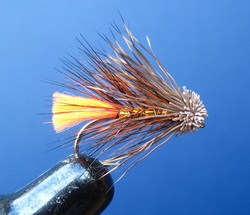
Thread – Black
Tail – Mixed Glo Brite fluo. floss No.7 Orange with No.5 Fire Orange.
Body – Flat gold or holographic gold.
Body Hackle – Hot orange cock & Black cock wound together.
Rib – Gold Wire.
Head - Spun Deer Hair with some fibres left as collar hackle.
Tail – Mixed Glo Brite fluo. floss No.7 Orange with No.5 Fire Orange.
Body – Flat gold or holographic gold.
Body Hackle – Hot orange cock & Black cock wound together.
Rib – Gold Wire.
Head - Spun Deer Hair with some fibres left as collar hackle.
Kate McClaren
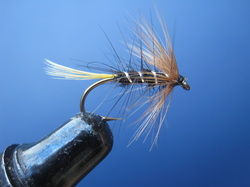
Thread – Black
Tail – Golden Pheasant crest.
Body – Black S.L.F. or similar.
Body Hackle – Black cock.
Rib – Fine or medium oval silver.
Head Hackle – Ginger or Red Brown hen.
Soldier Palmer
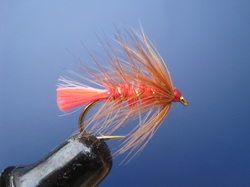
Thread – Black or red.
Tail – Red wool or Fluorescent red floss.
Body – red S.L.F. or similar.
Body Hackle – Red Brown or Ginger cock.
Rib – Fine or medium oval gold.
Head Hackle - Red Brown or ginger hen.
Loch Ordie
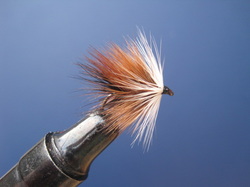
Thread: Black
Hackle: Hen hackles tied in up the shank beginning with black at the bend and progressing up through the shades of brown form dark chocolate to ginger before finishing off with a white hackle at the head.
Oakham's Orange
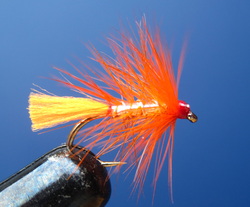
Thread – Black or orange.
Tail – Fluorescent orange floss.
Body – flat silver
Body Hackle – Hot orange cock.
Rib – Silver wire.
Head Hackle – Hot orange hen.
Orange Hedgehog
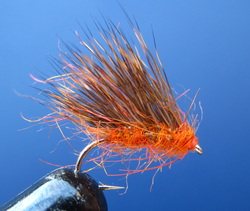
Thread – orange
Body – orange S.L.F. or similar.
Wing – Bunches of deer hair tied along the top of the hook shank.
Wickham's Fancy
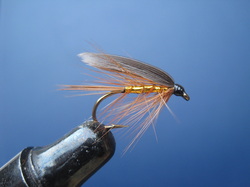
Thread – Black
Tail – Bunch of red/brown cock hackles.
Body – Flat Gold.
Body Hackle – Red/brown cock.
Rib – Gold Wire.
Wing – Usually listed as Mallard but anything grey will probably do.
Blue Zulu
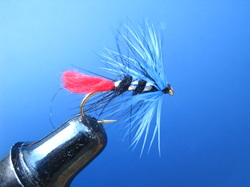
Tying Thread: Black
Tail: Red Wool
Body: Black SLF or similar.
Body Hackle: Black Cock
Rib: Flat Silver
Head Hackle: Blue Hen
Norski Lad (original)
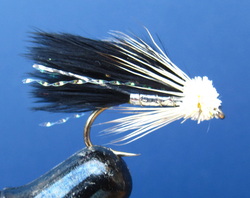
_ Tying Thread: White
Tail: Tuft of black marabou with a few strands of something silver & flashy over.
Body: Flat or holographic silver.
Rib: Silver wire.
Wing: Four strands of pearl Angel Hair under black marabou.
Head: Spun white Deer Hair with some fibres left as collar hackle.
Tail: Tuft of black marabou with a few strands of something silver & flashy over.
Body: Flat or holographic silver.
Rib: Silver wire.
Wing: Four strands of pearl Angel Hair under black marabou.
Head: Spun white Deer Hair with some fibres left as collar hackle.